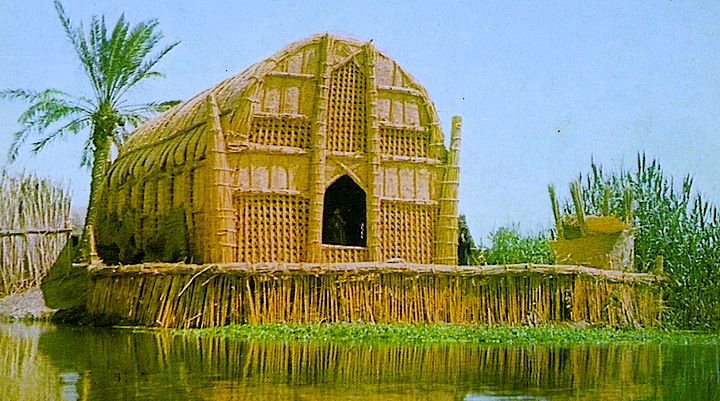Visual reference behind the story.
3D computer rendering of Ctesiphon created for a video game. Estimated date of around 400 AD. Credit: Unknown
The Tuhul, also known as "floating islands" or "reed islands," were developed by the region's ancient inhabitants, likely the Sumerians or their predecessors, who lived in the marshlands around 5000 years ago. These floating homes were an innovative response to the challenging environment of the marshes, where water levels could rise and fall dramatically. Constructed from bundled reeds, these dwellings allowed communities to live on the water, moving with the natural ebb and flow of the marshy landscape.
In the first century CE, the people who lived in the Mesopotamian tuhul dwellings were known as the Marsh Arabs or, specifically, the Ma'dan. These inhabitants of the marshlands in southern Mesopotamia, which includes modern-day southern Iraq (Sarifa community), have lived in this unique environment for thousands of years, adapting to the fluctuating water levels with their traditional floating homes made from reeds.
The Processional Way in ancient Babylon showcases grand walls lined with intricate blue-glazed bricks adorned with reliefs of animals, such as lions, bulls, and dragons, in yellow and white. Towering structures with crenelated tops, indicative of ancient Mesopotamian architecture, punctuate the walls. The Processional Way, a wide, paved street, leads towards the imposing Ishtar Gate, which stands as a monumental entrance to the city. Credit: Ancient Mesopotamia Strategy Game
This is an artist's rendition of the Ishtar Gate, one of Babylon's eight inner city gates, built around 575 BCE by order of King Nebuchadnezzar II. The gate is a grand architectural marvel constructed from blue-glazed bricks adorned with reliefs of animals and deities in yellow and white. The prominent archway is flanked by two large towers, each decorated with alternating rows of lions, bulls, and dragons, symbolizing the gods Marduk, Adad, and Ishtar. The walls are detailed with intricate patterns and bordered with geometric designs. Credit: Ancient Mesopotamia Strategy Game
Image: Archeology Illustrated by Balage Blaogh
Aerial view of Babylon City layout
Aerial view of Babylon City layout
This spot was the big "east-west pass" through Mount Alvand on your way from Ctesiphon to Ecbatana. It was the go-to summer spot for kings because of the cool, refreshing climate. The inscription on the upper left was created on the order of Achaemenid King Darius the Great (r. 522–486 BC), and the one on the right by his son King Xerxes the Great (r. 486–465 BC). They're etched with 20 lines of text in Old Persian, Neo-Babylonian, and Neo-Elamite, and aside from a different king's name, they're pretty much the same. They sing praises to Ahura Mazda, boast about royal bloodlines, and recount conquests.
An aerial view of Hamadan, a city in modern-day Iran, historically known as Ecbatana. The city sprawls across a vast area with a dense network of buildings and roads, showcasing a blend of urban development and historical significance. The landscape is surrounded by rugged mountains, providing a striking backdrop to the urban expanse. Ecbatana was once the capital of the Median Empire and later an important city in the Achaemenid Empire.
The Stone Lion of Hamadan, which once had a twin, was part of the old gate of the city of Ecbatana in Persia (modern-day Iran). According to some accounts, the lions were built upon the order of Alexander the Great (r. 336-323 BCE) to commemorate the death of his close companion, Hephaestion (l.c. 356-324 BCE), in 324 BCE—photo by by Carole Raddato.
Palmyra Gate at Dura Europolis
Palmyra Gate at Dura Europolis
Dura Europolis
Valley of Tombs outside Dura Europolis
Palmyra
Jupiter Temple at Damascus
Dura Europolis
Pool of Bethesda
Pool of Bethesda
Herod's Palace in Jerusalem
Arial view of Herod's Palace in Jerusalem
AntoniaFortress (tall round structure) in Jerusalem
Herod's colosseum
Temple Mount Jerusalem
Temple in Jerusalem
This structure in Hebron, built by Herod the Great, stands over the Cave of the Patriarchs. It is an impressive edifice that, through its engineering, conceals the actual cave, also known as Ma’arat HaMachpelah. According to Genesis 23, Abraham purchased the Cave of Machpelah as a burial place for his wife Sarah. He acquired the land from Ephron the Hittite for 400 shekels of silver, making it one of the earliest recorded land purchases in Jewish history. This site later became the burial place for Abraham, Isaac, Jacob, Rebecca, and Leah, thus cementing its importance as the second holiest site in Judaism, next to the Western Wall in Jerusalem. Adding to its significance, Hebron is where Zechariah, the father of John the Baptist, Elizabeth, and John (Jesus’ cousin) lived.


























